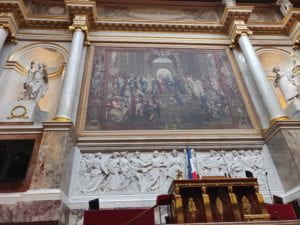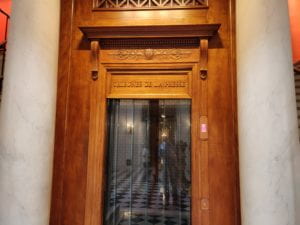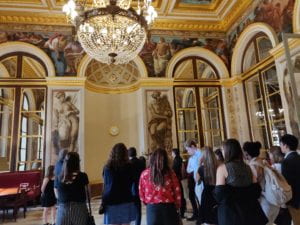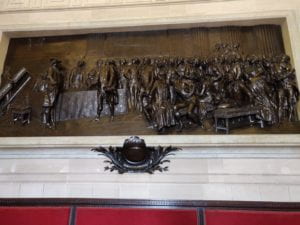Our visit to the National Assembly started at 8:10 AM when we departed. After going through security we were immediately greeted by our friendly guide that would teach us how the legislative branch of France works as well as some of the history behind the building. Our very first event was a short but compact six minute movie about the functions of the Assembly and Senate. The National Assembly is made up of 577 deputes that represent the different regions of France. These M.P.s will separate into different political groups and proposes different legislation. This legislation is passed between the senate and national assembly, but the national assembly has the final say.
After the movie we looked at some art on the outside of the room that depicted some of France’s history. On one side of the wall it showed 200 years of history after the revolution such as World War One, the right for women to vote, and the Treaty of Rome. On the other side there was a very controversial painting that depicted the slavery past of France. It depicts some black characters with exaggerated features that are classically seen as racist. The artist defends his work by talking about his experiences in many African countries and by saying that he paints all of his characters with the same faces.
In the large parliament room we saw were all of the M.P.s sit to vote on legislation and question the twenty ministers. This questioning is limited to fifteen questions and only two minutes for responses. Above the ministers the public may come and observe the sessions, and above that the press are invited to report on the events. In the center of the room there is the original speakers desk with a painting of ancient Greece on top to represent their founding principle: democracy. The seats are numbered, and each M.P. has a designated chair to record their vote without a doubt. They are also seated based on political party rather than region. The last change added some seats in the 1980s, but now there is a desire to reduce the number of seats for the sake of streamlining the national assembly.

Next was the largest reception room which was the ballroom. This was originally made by the daughter of King Louis XIV 300 years ago in order to accommodate her friend that she wanted to see. Outside there was an English style garden and on the other side there was a gallery that was made in order to show off paintings, but they were sold many years ago and replaced with tapestries.
The next interesting landmark was the Tribunes de la Presse. This is where the press had their own special elevator to go up to where they could observe the ongoing discussions. Afterwords we also saw the room of lost footsteps where press often had to wait for interviews with the M.P.s. This room was defined by the idea that peace is associated with technological progress. So the railway was depicted along with a steam engine. There was also a banner in this room that spoke about the early stance that France had come to in condemning other countries such as the United States in their continued segregation even during times of war.

The beautiful gardens outside were not only for the enjoyment of nature, but as a reminder to the important figures that have given their life for the democracy of France. There was a memorial for the thirty congressman that died in World War One and fifteen that died in World War Two. There was also a statue of Montesquieu who gave not only France but the United States the idea of balance of powers within the government. Finally there was a statue to represent the first time that women got to exercise their right to vote in 1945.
Next up was the Salle Delacroix. This beautiful room was painted by Delacroix and it showed all of France’s economy. On the ceiling there were the four main sources of wealth: agriculture, justice, industry, and war. The 5 main rivers of France were also painted here with a floor that was made with marble from all over France to represent the different regions of France. This room was originally the kings throne room which is why it is so focused on the wealth and power of France.
The main entrance was composed of some very important and meaningful art. Over the entrance was a painting which represented inefficiency and hostility. This meant to leave these things at the door and prepare for a productive and positive outlook which is what was painted on the opposite side. Under this a bronze sculpture was displayed that showed the start of the assembly as a celebration of the 100 years it had been standing.

Finally we ended in the conference room and library. These two rooms are the main place that M.P.s can get their work and research done. The library had a very extensive collection that was ten times the size of what books were visible at the top. The collection included some very important pieces such as one of ten original copies of the Joan of Arc trial and a 1000 year old copy of the bible. with such resources available to the M.P.s lets hope that they can keep serving their country and people with pride and efficiency.

Leave a Reply
You must be logged in to post a comment.